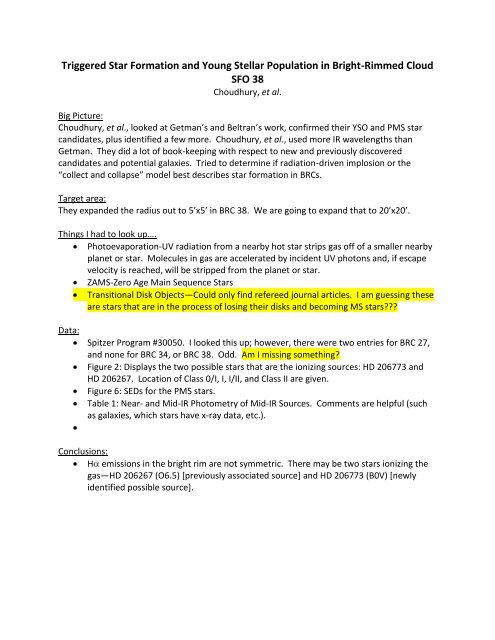Triggered Star Formation and Young Stellar Population in ... - CoolWiki
Triggered Star Formation and Young Stellar Population in ... - CoolWiki
Triggered Star Formation and Young Stellar Population in ... - CoolWiki
You also want an ePaper? Increase the reach of your titles
YUMPU automatically turns print PDFs into web optimized ePapers that Google loves.
<strong>Triggered</strong> <strong>Star</strong> <strong>Formation</strong> <strong>and</strong> <strong>Young</strong> <strong>Stellar</strong> <strong>Population</strong> <strong>in</strong> Bright-Rimmed Cloud<br />
SFO 38<br />
Choudhury, et al.<br />
Big Picture:<br />
Choudhury, et al., looked at Getman’s <strong>and</strong> Beltran’s work, confirmed their YSO <strong>and</strong> PMS star<br />
c<strong>and</strong>idates, plus identified a few more. Choudhury, et al., used more IR wavelengths than<br />
Getman. They did a lot of book-keep<strong>in</strong>g with respect to new <strong>and</strong> previously discovered<br />
c<strong>and</strong>idates <strong>and</strong> potential galaxies. Tried to determ<strong>in</strong>e if radiation-driven implosion or the<br />
“collect <strong>and</strong> collapse” model best describes star formation <strong>in</strong> BRCs.<br />
Target area:<br />
They exp<strong>and</strong>ed the radius out to 5’x5’ <strong>in</strong> BRC 38. We are go<strong>in</strong>g to exp<strong>and</strong> that to 20’x20’.<br />
Th<strong>in</strong>gs I had to look up….<br />
Photoevaporation-UV radiation from a nearby hot star strips gas off of a smaller nearby<br />
planet or star. Molecules <strong>in</strong> gas are accelerated by <strong>in</strong>cident UV photons <strong>and</strong>, if escape<br />
velocity is reached, will be stripped from the planet or star.<br />
ZAMS-Zero Age Ma<strong>in</strong> Sequence <strong>Star</strong>s<br />
Transitional Disk Objects—Could only f<strong>in</strong>d refereed journal articles. I am guess<strong>in</strong>g these<br />
are stars that are <strong>in</strong> the process of los<strong>in</strong>g their disks <strong>and</strong> becom<strong>in</strong>g MS stars???<br />
Data:<br />
Spitzer Program #30050. I looked this up; however, there were two entries for BRC 27,<br />
<strong>and</strong> none for BRC 34, or BRC 38. Odd. Am I miss<strong>in</strong>g someth<strong>in</strong>g?<br />
Figure 2: Displays the two possible stars that are the ioniz<strong>in</strong>g sources: HD 206773 <strong>and</strong><br />
HD 206267. Location of Class 0/I, I, I/II, <strong>and</strong> Class II are given.<br />
Figure 6: SEDs for the PMS stars.<br />
Table 1: Near- <strong>and</strong> Mid-IR Photometry of Mid-IR Sources. Comments are helpful (such<br />
as galaxies, which stars have x-ray data, etc.).<br />
Conclusions:<br />
H emissions <strong>in</strong> the bright rim are not symmetric. There may be two stars ioniz<strong>in</strong>g the<br />
gas—HD 206267 (O6.5) [previously associated source] <strong>and</strong> HD 206773 (B0V) [newly<br />
identified possible source].
BRC 38<br />
Known Active <strong>Star</strong>form<strong>in</strong>g<br />
region<br />
Getman<br />
Beltran<br />
X-ray data from<br />
Ch<strong>and</strong>ra<br />
Spitzer MIR (only up<br />
to 5.8 m<br />
Supported RDI<br />
model based on<br />
distribution <strong>and</strong> age<br />
of those few Mid-IR<br />
Sources<br />
Used NIR imag<strong>in</strong>g<br />
Does not favor RDI model<br />
Did not see abundance of star formation<br />
<strong>in</strong> the rim, <strong>and</strong> did not see a pattern <strong>in</strong><br />
YSO evolutionary stages from the ioniz<strong>in</strong>g<br />
star to the BRC.<br />
BRCs need to be studied <strong>in</strong> more<br />
wavelengths.<br />
Absence of NIR excess does not mean star<br />
is more evolved. Ioniz<strong>in</strong>g star could have<br />
removed ambient gas.<br />
Choudhury<br />
Argued that the ioniz<strong>in</strong>g star <strong>in</strong> BRC 38 would not affect the older-appear<strong>in</strong>g stars s<strong>in</strong>ce<br />
the ioniz<strong>in</strong>g star is ~9pc. The ioniz<strong>in</strong>g star has to be less than 1 pc away to have any<br />
effect on remov<strong>in</strong>g the ambient gas on a protostar.<br />
The age distribution of stars <strong>in</strong> BRC 38 do show an evolutionary track.<br />
HD 206773 is affect<strong>in</strong>g the eastern part of the bright rim <strong>and</strong> HD 206267 is affect<strong>in</strong>g<br />
the Western rim of BRC 38.<br />
When consider<strong>in</strong>g an age gradient, both ioniz<strong>in</strong>g stars need to be considered.<br />
Their results are consistent with SSSSF <strong>and</strong> RDI.


